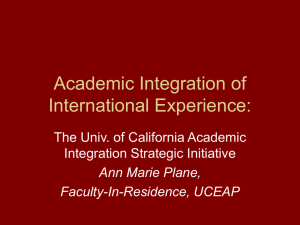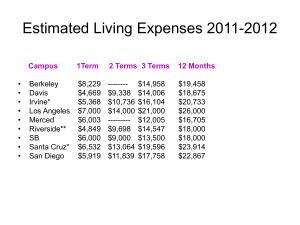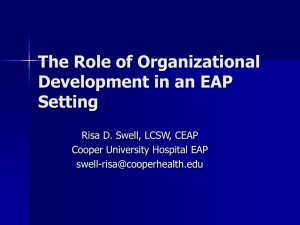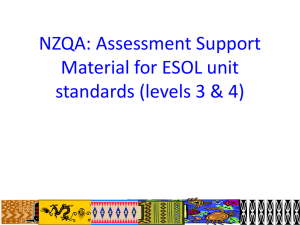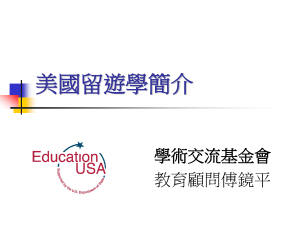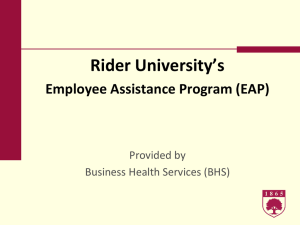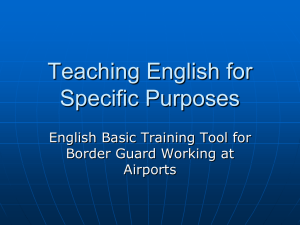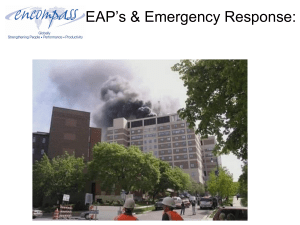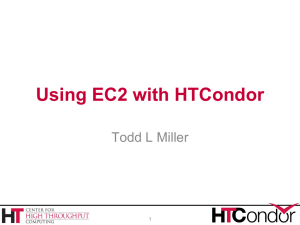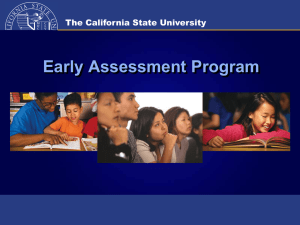ESP Teaching and Research
advertisement
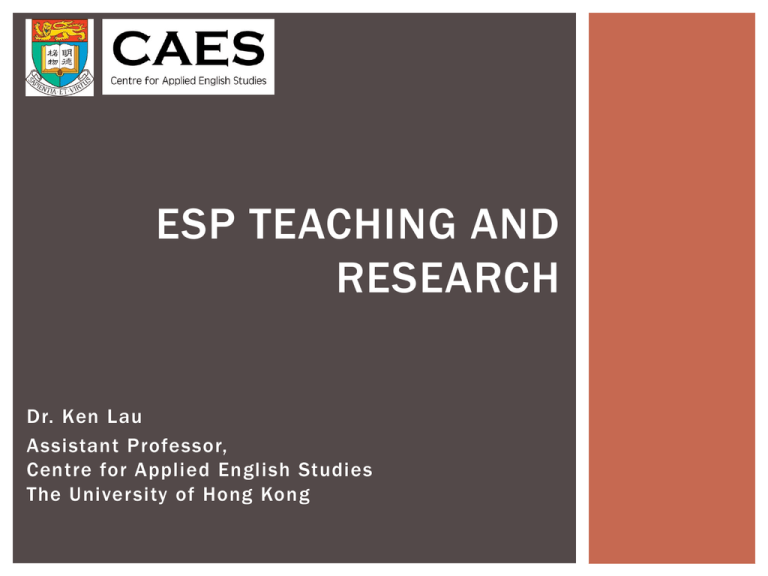
ESP TEACHING AND RESEARCH Dr. Ken Lau Assistant Professor, Centre for Applied English Studies The University of Hong Kong COURSE SCHEDULE Time Activities 9:00-9:10 Opening Remarks 9:10-10:30 10:30-10:40 10:40-12:10 12:10-1:20 ESP Teaching and Research I: Arts and Humanities Tea Break ESP Teaching and Research II: Science and Engineering Lunch 1:20-3:00 3:00-3:10 Corpus-Informed Teaching and Research I Tea Break 3:10-4:40 Corpus-Informed Teaching and Research II ACKNOWLEDGEMENTS Thanks to colleagues of the Centre for Applied English Studies who have generously shared their course materials for illustration purposes. A DEFINITION English for Specific Purposes (ESP) has been defined by a number of researchers. One of the most oft -cited definitions is from Hutchison and Waters (1987) who see ESP as an approach rather than a product, meaning that ESP does not imply a particular kind of language, teaching material or methodology. The central idea in their definition lies in the construct of need. “Need is defined by the reasons for which the student is learning English, which will vary from study purposes such as following a postgraduate course in an English -speaking country to work purposes such as participating in business meetings or taking hotel bookings” (Dudley -Evans & St John, 1998, p.3). CLASSIFICATION OF ESP THE CASE OF CAES Faculty Course Nature of the course: EAP/EOP Architecture Communication Course for Architecture Students EAP Arts Academic English for Arts Students EAP Business & Economics English for Academic Communication for Economics and Finance Students EAP Dentistry English for Dental Students ? Education Academic English for Education Students EAP Engineering Professional and Technical Written/Oral Communication for Engineers EAP Law Writing Solutions to Legal Problems EAP Medicine English for Clinical Clerkship EOP/EAP Science Academic English for Science Students EAP Social Sciences Professional Writing Skills for Social Work EOP NEEDS ANALYSIS Needs cover a wide range of issues such as learner’s goals, backgrounds, proficiency, reasons for taking the course, the situations where they need the communication knowledge and skills, etc. Present Situation Analysis (PSA) Learning Situation Analysis (LSA) Target Situation Analysis (TSA) PRESENT SITUATION ANALYSIS (PSA) PSA refers to information about learners’ current abilities, familiarity with the written and spoken genres, their skills and perceptions; what they are able to do and what they want at the beginning of the course. Data can therefore be both objective (age, proficiency, prior learning experiences) and subjective (self-perceived needs, strengths and weaknesses). I have difficulty selecting appropriate word choices when writing a feasibility report. LEARNING SITUATION ANALYSIS (LSA) LSA is concerned with the learners, teachers and teaching and learning contexts. It includes subjective, self -perceived, process-oriented needs. I am more comfortable working on my own than in groups. TARGET SITUATION ANALYSIS (TSA) TSA concerns the learner’s future roles and the linguistic skills and knowledge required to perform competently in a target context. This involves mainly objective and product oriented data: identifying the contexts of language use, observing the language events in these contexts, listing the genres employed, collecting and analyzing target genres . I have to draft an assessment report after seeing a client. To collect needs data, teachers can draw on a range of dif ferent sources and techniques such as interviews, questionnaire surveys, observations. DISCUSSION Imagine you are asked by your department head to create an ESP course for social workers entitled “Professional Writing Skills for Social Work”. What kind of (1) writing and (2) language needs do you plan to cover in the course? COURSE DESIGN How are the topics structured? SAMPLE MATERIALS – SOCIAL WORK SAMPLE MATERIALS – SOCIAL WORK LANGUAGE MATERIALS – SOCIAL WORK The following are some of the salient language features in social work: Description of behaviours and emotions Using non-judgmental language Using reported speech DESCRIPTION OF BEHAVIOURS AND EMOTIONS DESCRIPTION OF BEHAVIOURS AND EMOTIONS USING NON-JUDGMENTAL LANGUAGE USING NON-JUDGMENTAL LANGUAGE FUNCTIONAL GRAMMATICAL ANALYSIS FUNCTIONAL GRAMMATICAL ANALYSIS FUNCTIONAL GRAMMATICAL ANALYSIS REPORTED SPEECH WRITING SOLUTIONS TO LEGAL PROBLEMS This 3-credit English enhancement course of fered in the 2nd semester aims to enable first -year LLB students and 2nd year joint-degree law students to adapt and develop their existing language, reasoning, and study skills, and to apply and articulate their knowledge of tort law , as they frame a written response to the kinds of legal problem solution assignment. Only Negligence and Psychiatric Injury are dealt with in the course. TEACHING APPROACH Assignment Genre Legal Problem Legal content, study skills, Legal Practices Progression Weeks 1/2 Disciplinary Reasoning “moves” Weeks 2/3 Rhetorical structure Other language features Weeks 3/4 AN EXAMPLE OF PQ One day, when walking home, William trips and falls, damaging his knee. Several days later, while driving to work, he sees Victor crossing the road and brakes to avoid running into him. Unfortunately, due to the pain in William’s knee, he cannot fully press his brake pedal and as a result he runs into Victor. The collision occurs at a fairly slow speed and a normal person would only have suf fered bruising as a result, but Victor has brittle bones and suf fers two broken legs and a number of broken ribs. He is taken to the local hospital where, due to an administrative mistake, his right arm is amputated. Advise Victor. FIRST STEP – CASE ANALYSIS To identify the legal issues involved and to be addressed in the PQ The collision occurs at a fairly slow speed and a normal person would only have suffered bruising as a result, but Victor has brittle bones and suffers two broken legs and a number of broken ribs. Remoteness: If the defendant is negligent, the plaintiff's right to recover damages is not limited by the fact that his injury resulted from aggravation of a preexisting condition. Where an injury arising from a cause which entails liability on the defendant combines with a pre -existing condition to bring about a greater harm to the plaintiff then would have resulted from the injury alone, the defendant may be found liable for all of the consequences. [Thin-skull rule] FIRST STEP – CASE ANALYSIS SECOND STEP – LEGAL REASONING MOVES Common Law Legal Reasoning Flow - IPCAC: Issue – Articulating the issue in terms of the parties and the facts Principle – invoking a legal principle and/or rule Case – relying on precedent cases and/or legislation Application – applying precedent case and/or legislation to the facts of the present case Conclusion – articulating the (recommended) decision, and grounds for reaching it SECOND STEP – LEGAL REASONING MOVES Legal Reasoning Moves Assuming that William is held to have caused the accident, Victor would next have to show that the injuries she suffered were not too remote a consequence of William’s actions. The usual rule that a D is only responsible Issue for harm of a foreseeable type is modified to some extent by the `thin skull’ Principle rule. The operative principle here was set out in Smith v Leech Brain. The Case court held that in cases where the harm inflicted was of a foreseeable type, the defendant will be liable for the full extent of the injury, even if the full extent was unforeseeable. Thus, the tortfeasor is said to `take his victim as he finds him.’ Applying this principle to the present case, the fact that Victor Application had brittle bones and suffered more seriously than normal people might otherwise have been, is irrelevant. William will thus be liable to compensate Victor for his broken legs and ribs. Conclusion THIRD STEP – RHETORICAL STRUCTURES Issue NOT Arguable - Deductive Structure Mary was clearly prima facie in breach of her duty. The standard of care for Analysis Deductive structure is recommended – it is NOT arguable Mary should be a reasonable customer’s behaviour in a supermarket (Glasgow Corp v Muir). Being in a hurry to get home does not suggest an emergency or any other grounds for holding Mary to a lower standard of care towards the supermarket. You don’t succeed point by point or issue by issue – you do that for the overall action THIRD STEP – RHETORICAL STRUCTURES Issue Arguable – Inductive Structure Analysis / Points to Note We need to determine whether or not Norah’s action of putting her basket down in Mary’s way breached her Issue: Breach of Duty duty to Mary. The objective standard of care of a supermarket’s customer may indicate it was Principle reasonable for Norah to put down her shopping basket in order to reach up for something like the jar of coffee “suddenly” putting down the basket “in the way of” Case Application someone walking close to her suggests she fell below Conclusion (Glasgow Corp v Muir). However, Norah’s action of that standard (i.e. breached her duty). FOURTH STEP – LANGUAGE (CONDITIONAL SENTENCES) PROFESSIONAL AND TECHNICAL WRITTEN COMMUNICATION FOR ENGINEERS This course aims to provide an intensive English environment within the Engineering syllabus which will engage students in problem solving activities that are representative of the engineering disciplines, give you the opportunity to communicate in English and build up their confidence in using the language. PROFESSIONAL AND TECHNICAL WRITTEN COMMUNICATION FOR ENGINEERS The course involves a Design and Make Project for which students in groups have to create an Elastic Powered Paper Vehicle (i.e. using recycled paper to make a car which is powered by one elastic band) with the given specifications. The production of the vehicle itself is not assessed but students are assessed on two things in relation to the project Conduct a series of meeting and come up with minutes Write a technical report with appropriate diagrams PROFESSIONAL AND TECHNICAL WRITTEN COMMUNICATION FOR ENGINEERS The followings are the sections required in the technical report: Summary Introduction Materials and Specifications Engineering Principle Construction Procedures 1 and 2 Test Procedure Discussion of results Conclusion SAMPLE MATERIALS - ENGINEERING STUDENTS’ WORK - ENGINEERING SAMPLE MATERIALS - ENGINEERING SAMPLE MATERIALS - ENGINEERING ADVANCED ENGLISH FOR SCIENCE STUDENTS Students will write a popular science journal article for a web journal targeting a non-specialist audience. Students will be challenged to engage in spontaneous speaking task in a small group setting while in class. Students will be provided with guidance in developing a self -access language learning (SALL) plan, carrying this out, and reflecting on their learning experience and learning strategies used. Pre-requisite: Students taking this course have to pass the first-year course on academic writing so students will have already learnt how to write an essay with the use of reliable sources and proper acknowledgements. SPECIAL FEATURES An important feature of the course is the emphasis on learner autonomy and choices. A significant proportion of the time of the course requires students to undertake self -access language learning. Such a decision is based on the results of the needs analysis (see Gardner 2007 ): With more than 400 students taking the same course, there is a very wide range of language abilities The logistical/scheduling arrangements give rise to the learning situation that students of different majors under the same Faculty are mixed together in a class According to the statistics gathered by the University in 2001, only around 40% of the science graduates took up science -related employments. G a r d n e r, D . ( 2 0 07 ) . I n t e g r a t i n g s e l f - a c c e s s l e a r n i n g i n t o a n E S P c o u r s e . I n D . G a r d n e r ( e d . ) , L e a r n e r a u t o n o my 1 0 : I n t e g r a t i o n a n d s u p p o r t ( p p . 8 - 3 2 ) . D u b l i n : A u t h e n t i k . CLASS ARRANGEMENTS In most of the sessions they are divided into two 1 -hour slots. Half of the students will come for one hour for spontaneous speaking practice and the other half will be working on SALL. The arrangements will be swapped in the second hour. In total, students are required to take part in at least 8 hours of SALL by the end of the course. Students have to identify several learning goals, formulate a study plan, look for independent learning resources and reflect on their learning experiences. PROFESSIONAL AND TECHNICAL ORAL COMMUNICATION FOR ENGINEERS The course introduces engineering students to professional and technical communication in the context of oral presentations. The course will provide an intensive English environment within the Engineering syllabus which will engage students in verbal communicative activities that are representative of the engineering disciplines. Students work in groups and individually, make decisions on gathering and reformulating data, and select the appropriate language and register to deliver professional presentations to a range of audience. PROFESSIONAL AND TECHNICAL ORAL COMMUNICATION FOR ENGINEERS • Compulsory for all first-year Engineering students (>400 students) • 12 weeks, 24 contact hours • Three presentation assessments (Diagnostic Pair, Group and Individual) • Out-of-class learning component • Self-Access and Reflection (SAR) Record Two weaknesses identified by the teacher Weakness identified by the student Self Assessment and Reflection Evaluation of resources chosen and used, and the quality of reflection Improvement shown in the next presentation QUESTIONS AND ANSWERS

